Selling Beeswax: How Much Money Can You Make? Profitable?
Whether you’re an experienced beekeeper or new to the hobby, you will have to do something with your beeswax, so why not sell it? Some beekeepers prefer to process it and sell it locally, while others prefer to sell it in bulk to commercial wax renderers. Either way, what is a realistic amount of money that you can expect to sell your beeswax for?
You can earn between $6 to $20 per lb for selling your beeswax. The prices will vary depending on the grade(food, pharmaceutical, industrial) or purity of the beeswax, if the wax is in large blocks or pellet form, the color, your local region, and if the beeswax is certified organic.
Selling your beeswax is another potential income stream to help recoup the costs of your hives. I’ll explore the different aspects of selling your beeswax such as realistic price expectations, the different grades of beeswax, and how much you can harvest from one hive.
Can You Make Money Selling Beeswax
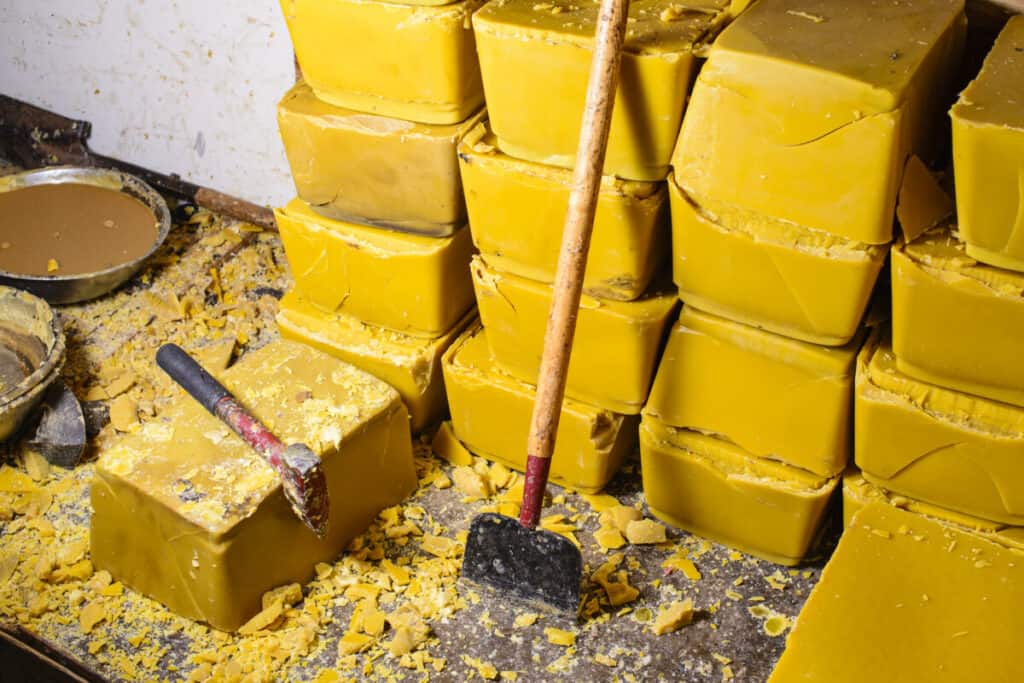
Now that you’ve gained more experience and have begun to harvest your honey, selling your beeswax is another potential income stream. But like all aspects of beekeeping rendering or processing your beeswax is time consuming, labor intensive, and costly depending on the equipment you’re using.
Are you going to be profitable just from selling your beeswax? Maybe, but not likely especially as a beginner beekeeper. But it is another income stream that will help you either cover your apiary costs or potentially make you profitable. It takes multiple income streams to be profitable as a beekeeper. But beekeeping is one of the cheapest or cost effective ways for people to get started in agriculture.
And for other available income streams, hold up for just a bit, I wrote an article all about how many beehives it takes to make a living that I encourage you to read!
Now the amount of money you can sell your beeswax for is really going to depend on your overall goals as a beekeeper. Some beekeepers prefer to render their own beeswax and can afford the cost of the wax rendering equipment. Then sell the beeswax in different size blocks to either retail customers or in bulk to a variety of companies.
While other beekeepers prefer to make different products out of the beeswax such as: candles, food wraps, lip balms etc., and sell those products direct to retail customers. These beekeepers will often buy beeswax from other beekeepers as well since they usually cannot produce enough themselves for the products they make.
At the end of the day, deciding how you wish to sell your beeswax is going to depend on your overall goals and financial resources. Also, keep in mind as you build a larger apiary your beekeeping goals are going to change and you will have more beeswax to deal with. Now for the price breakdown!
Here is the price range for selling beeswax based on Country:
United States – $6 to $20 per lb. The price varies considerably depending on the grade of the beeswax, the color, and if its in large blocks or pellet form. These prices are in US dollars.
Canada – $11 to $22 per lb. Similar to the United States the price you can demand is dependent on the grade of the beeswax, the color, and if its in large blocks or pellet form. These prices are in Canadian dollars.
United Kingdom – £13 to £26 per kg. Again the price you can demand will vary on the grade or quality of the beeswax, its color, and if its in large blocks or pellet form. These prices are in Pound sterling.
Australia – $30 to $50 per kg. The price varies considerably depending on the grade of the beeswax, the color, and if its in large blocks or pellet form. These prices are in Australian prices.
The price ranges I’ve listed above are based on the average prices demanded across a wide number of regions in each Country. They are very realistic price ranges but please keep in mind these are only estimates and I urge you to double check the pricing being demanded in your local region.

Also the prices above are for selling your raw beeswax. But what about selling your beeswax in different retail products? There is some very common forms of beeswax that are sold, such as beeswax candles but beeswax is used in so many different products.
Here is a pretty lengthy list of products made from beeswax but is in no way an exhaustive list:
- Beeswax Candles – pretty obvious one and one of the most popular. Many candle makers prefer to use beeswax in the pellet form since it melts faster than large blocks of beeswax. It is also used in aromatherapy because beeswax burns very slow and mostly smoke free while giving off a nice honey aroma.
- Food Wraps – these have become very popular and is a great product to sell.
- Cosmetics – beeswax is used in a ton of cosmetic products such as soaps, lip balms, lip gloss, hand creams, moisturizers, lotions, moustache wax, hair pomades (hair wax), eye shadow, blush, and eye liner. Cosmetic companies only use cosmetic grade beeswax and prefer their wax in pellet form rather than in large blocks.
- Food Industry – beeswax is used for a variety of products in the food industry. It is most commonly used for coating cheeses, in some natural chewing gums and sometimes used as a glazing agent.
- Lubricants – used for surf boards, curtain runners, or simply fixing stuck zippers. It can be used on skis but there is mixed reviews on how effective its use is for both downhill or cross-country skiing.
- Polishes – used in furniture and shoe polishes. Beeswax is also used in woodworking, leather-working, and metalsmithing.
- Waterproofing – beeswax has been used for years for waterproofing cutting boards, sealing corks, waterproofing leather, belts, gloves, shoes or boots, tents, and backpacks. Beeswax is a very versatile product for waterproofing.
- Pets – there is even types of beeswax for your pets paws, called paw wax. It’s used to protect your pets sensitive paws from the rough concrete, ice, snow, sand, salt, and hot pavement. I’ve never used this but it is quite popular and there is quite a few different retailers whom sell it.
Since beeswax is used in so many different products, it offers a wide range of business opportunities for a beekeeper. Of course all these different products require differing grades of beeswax.
The Different Grades Of Beeswax
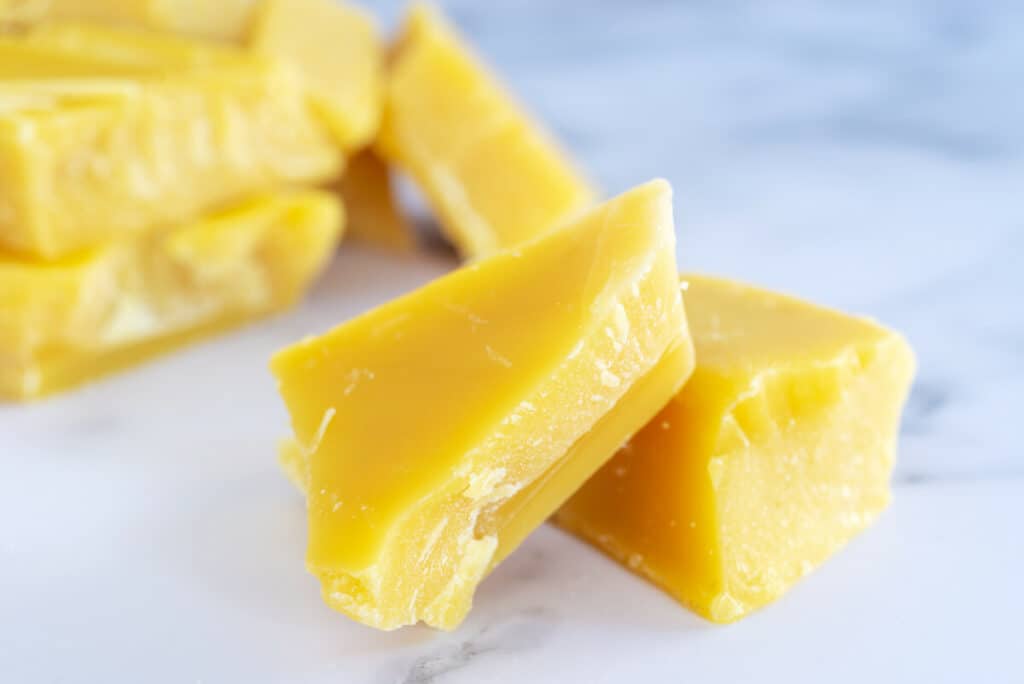
There is often some confusion when discussing the different grades of beeswax and every country grades their beeswax differently. There is a wide variety of differing laws and regulations when it comes to beeswax being used in cosmetics, the food industry, and to be classified as certified organic.
When discussing the different grades of beeswax the grades are often intermixed with the 3 main colors of yellow, white or ivory, and a dark or brownish color. The color of the beeswax does not necessarily indicate the grade but does offer some guidance.
The Three Most Common Grades Of Beeswax
1. General Use or Industrial Grade – this is 100% raw beeswax taken from the beehive. It can be sold as unfiltered and not rendered at all or it can be rendered with filtering. If the beeswax hasn’t been filtered or rendered down it will be a dark or brownish color. You will get the lowest price when selling this beeswax.
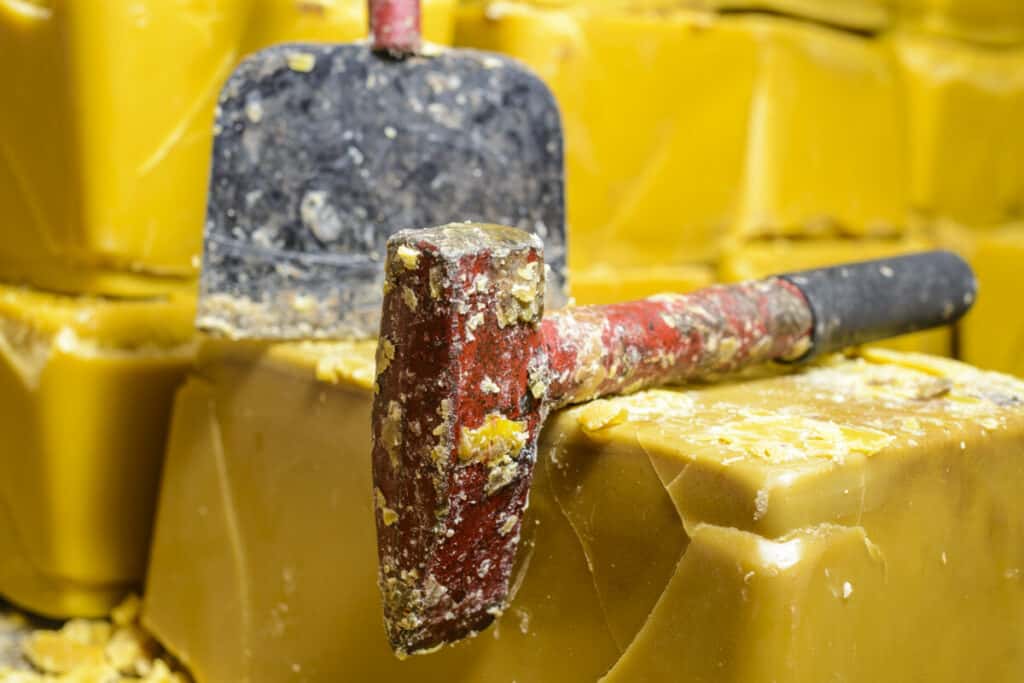
If the beeswax has been rendered with some basic filtering then it will be yellow in color. This form will demand a higher price and is often used for candles and sold in blocks. This beeswax will have different aromas depending on the region it is harvested from.
Industrial grade beeswax is also used for wood sealants and furniture polishes.
The beeswax can be further filtered, in some cases triple filtered, by using a 1 micron charcoal filter or a 1 micron carbon filter and this produces a white or ivory color beeswax.
2. Premium, Cosmetic or Pharmaceutical Grade – this form of beeswax is often heavily regulated depending on the country or region.
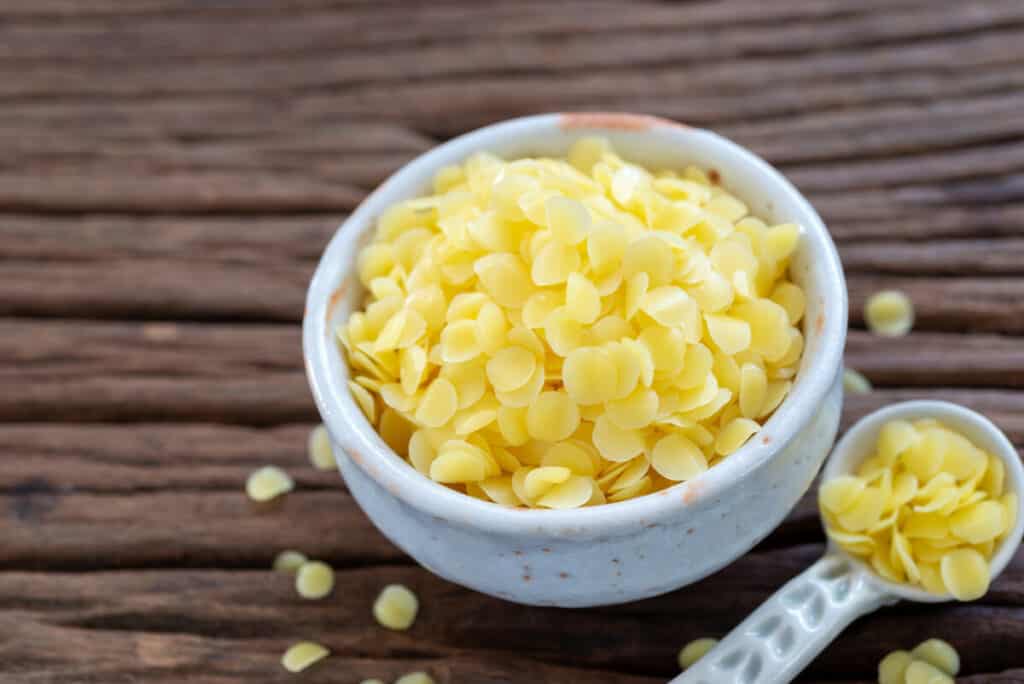
This grade of beeswax is heavily filtered, in some cases bleached, and is sold in both block or pellet form. Pellet form is preferred by most companies due to its ease of use in production. The pellet form of beeswax is also commonly referred to as refined beeswax.
It’s usually tested for the following; melting range (melting point), clouding point, flash point, boiling point, iodine value, acid value, esters and ester value, saponification value, hydrocarbons, fatty acids, density, solubility, and sometimes the peroxide value.
Companies that sell premium quality beeswax will document the extraction method, appearance, odour, and the source of the beeswax along with the above listed lab tests. In most cases the company will provide a beeswax certificate of analysis to prove the purity of their beeswax. Here’s an example from Canadabeeswax.ca.
Depending on your region and how the wax is filtered, this grade of beeswax is also considered to be food grade.
3. Food Grade or Absolute White – is beeswax that is treated with alcohol for food preparation. It is often used for coating cheeses, used in soft gelatin capsules, sometimes as a glazing agent and even in some natural chewing gums.
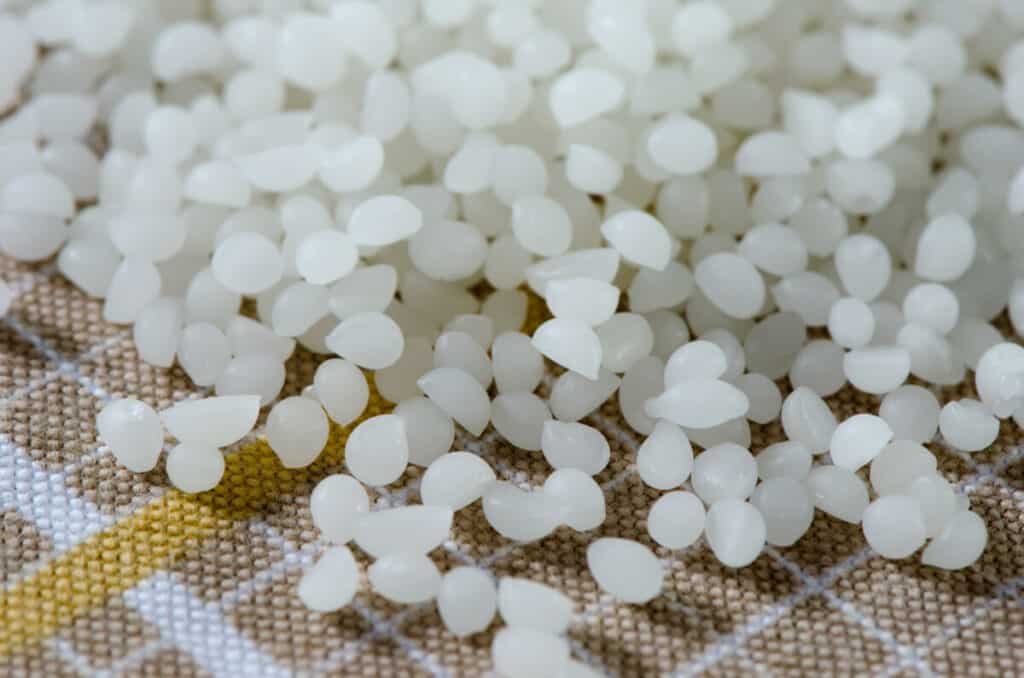
Keep in mind not all food grade beeswax has been treated with alcohol like the beeswax being sold out of Canada listed above. And not all food grade beeswax is white in color it can also be a light yellow color. This is what is so confusing about the sale of beeswax in the retail and commercial markets.
I didn’t mention organic beeswax in this list because it is a bit trickier to claim certified organic beeswax depending on the country or region. Unfortunately a lot beeswax retailers that are claiming their beeswax as organic are making false claims. it is often imported from other countries with less regulations and more impurities.
I would air on the side of caution when there is a claim of organic beeswax, always verify the source when it comes to organic.
How Much Beeswax Do You Get From A Hive
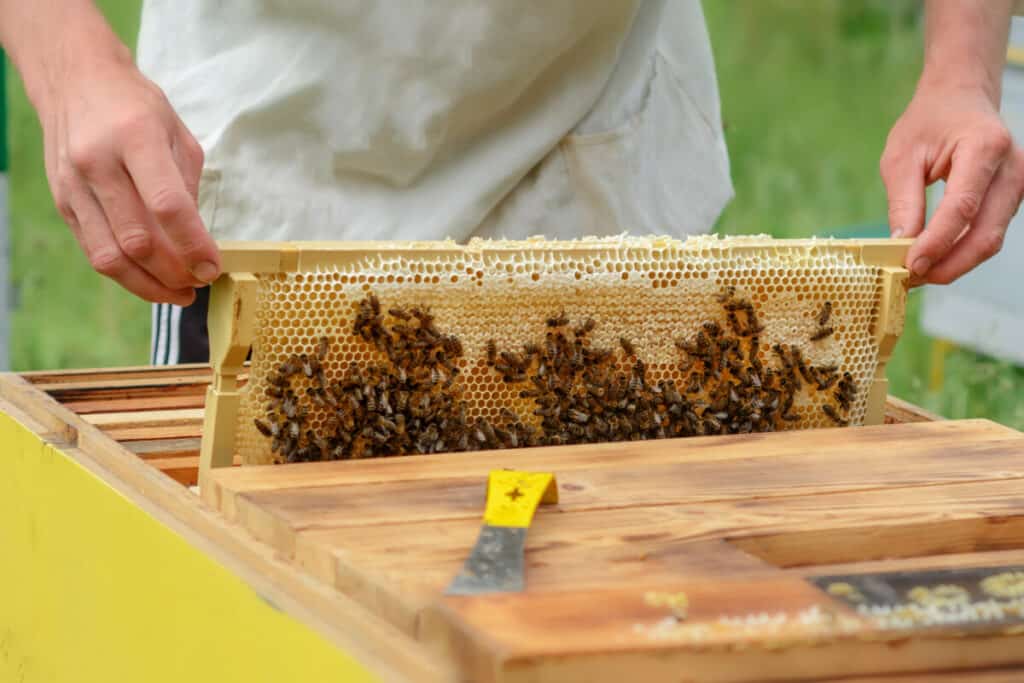
This is always a big topic of discussion especially as a new or beginner beekeeper. You will find the method you use to harvest your honey will greatly impact how much beeswax you can collect. If you use the crush and strain method you will collect more wax than if you use a frame extractor. By using a frame extractor you can only collect the wax cappings.
You can collect between 1 to 1.5 lbs of beeswax by using the crush and strain method from a hive that produces between 60 to 80 lbs of honey. If you’re using a standard frame extractor you can collect between 1/2 to 1 lb of beeswax from a hive that produces 60 to 80 lbs of honey.
Most beekeepers don’t track the amount of beeswax they collect by the hive but by the pound of honey they produce. A realistic guideline is you can collect around 1% to 1.5% of the total amount of honey harvested. Which equates to around 1 to 1.5 lbs of beeswax per 100 lbs of honey harvested.
This is why most beekeepers consider beeswax a byproduct from beekeeping and focus on the honey production side of the business. Beekeepers will commonly use commercial wax renderers to either assist with the processing of their beeswax or simply sell it to them. At least until they have enough hives to make purchasing the wax rendering equipment worthwhile.
It takes a lot of hives to produce a significant amount of beeswax. Most beekeepers don’t use the crush and strain method because they will produce far less honey. You end up destroying all the comb in your honey supers and the bees will have to rebuild it next year. Honey supers with comb are very valuable to a beekeeper.
And if you want some guidance on selling your honey, hold up for just a bit, I wrote an article all about how much money you can make selling your honey that I encourage you to read!
Some larger commercial beekeepers will have some hives set aside just for wax production but that isn’t the norm. You will need to use frames with no foundation if your collecting the wax.
Also, most beekeepers that setup hives for wax production will setup hives for harvesting honeycomb. This makes sense since you have to use the same frames with no foundation to collect honeycomb. If selling honeycomb is an income stream you’d like to explore then check out this article I wrote about how much money you can make selling raw honeycomb.
You have to consider if the revenues from wax production offset the loss of revenues from honey production. In most cases it doesn’t until you have a lot more hives and are able to sell the highest grade wax, which can bring in a decent amount of revenue.
Or as you expand your apiary you may decide to get into the wax rendering business. There is a few companies in every region that have a good revenue model by rendering wax for local beekeepers and selling it to larger companies. Keep in mind becoming a wax rendering business does require investing in thousands of dollars in equipment to efficiently clean and purify the beeswax.
Here is great video demonstrating how a beekeeper, Kaymon Reynolds from Tennessee, renders his beeswax:
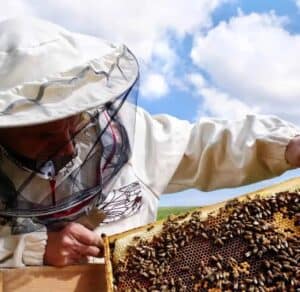
Joseph Davis
My goal is to show that anyone can take up beekeeping and it can be a very rewarding hobby. I strive to share my experiences and answer any questions you may have.
